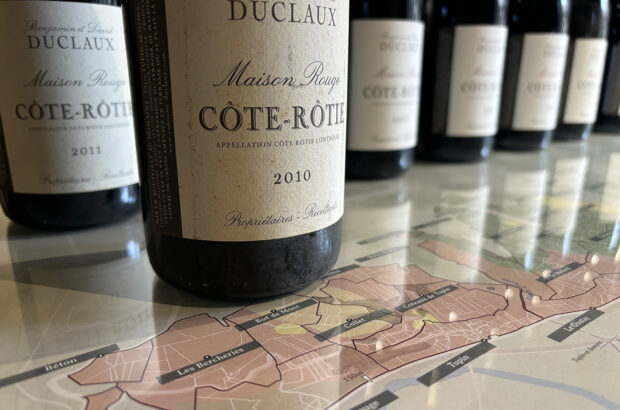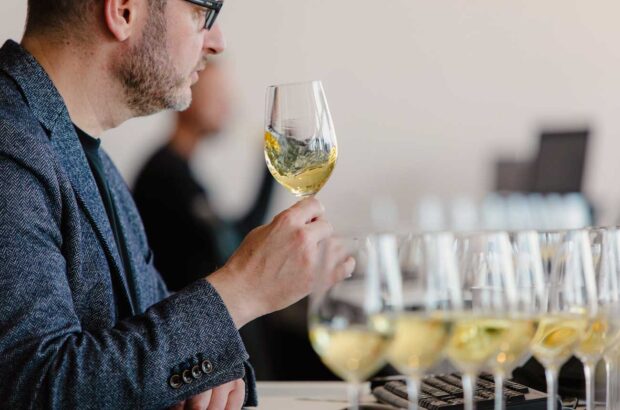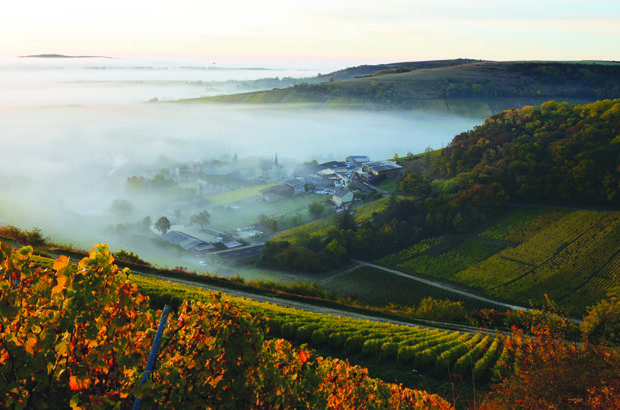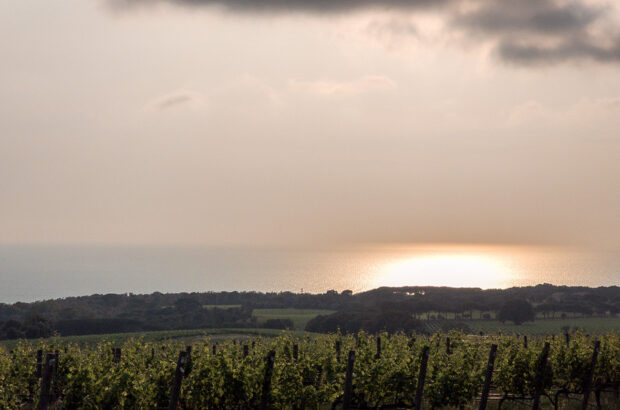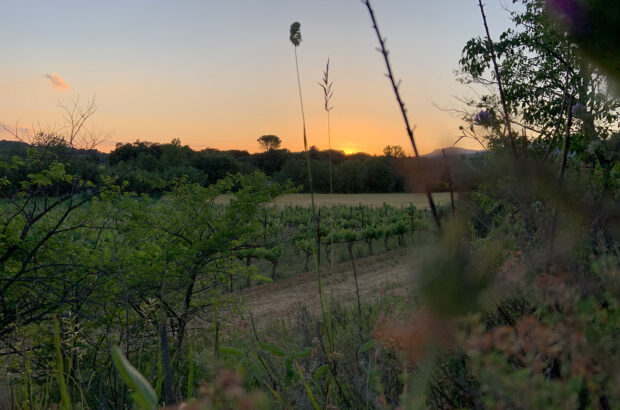One vine of Château Cheval Blanc’s vineyard carries just five or six clusters of grapes. That barely makes one bottle of wine, and – in the case of this esteemed Right Bank estate – about £500 worth of wine, depending on the vintage.
You could say these vines are almost worth their weight in gold… So why then has Cheval Blanc uprooted over 3,000 vines in order to plant humble fruit trees in the vineyard instead?
Scroll down to see tasting notes and scores for a selection of Château Cheval Blanc and Cheval des Andes wines
This tree planting is part of Cheval Blanc’s rather radical agroecology plan, which has been evolving since 2009 in a bid to mitigate the impact of climate change on the estate’s wines.
‘If we don’t change the way we manage the vineyard today, it will be too late and our wine will change forever,’ explains technical director Pierre-Olivier Clouet. ‘Climate change will bring higher alcohol, drier tannins, riper fruit… So we had to make a significant change to the whole estate – not just by experimenting with one or two rows.’
The team has planted 80 trees per hectare of vines; not only surrounding the vines with hedgerows, woodlands and wildlife corridors but actually planting tree saplings within the vine rows, replacing some vines.
{"content":"PC9wPgo8ZGl2IGlkPSJhdHRhY2htZW50XzQ3NzIxNiIgc3R5bGU9IndpZHRoOiAxMzEwcHgiIGNsYXNzPSJ3cC1jYXB0aW9uIGFsaWdubm9uZSI+PGltZyBmZXRjaHByaW9yaXR5PSJoaWdoIiBkZWNvZGluZz0iYXN5bmMiIGFyaWEtZGVzY3JpYmVkYnk9ImNhcHRpb24tYXR0YWNobWVudC00NzcyMTYiIGNsYXNzPSJsYXp5bG9hZCBibHVyLXVwIHdwLWltYWdlLTQ3NzIxNiBzaXplLWZ1bGwiIGRhdGEtcHJvY2Vzc2VkIHNyYz0iaHR0cHM6Ly93d3cuZGVjYW50ZXIuY29tL3dwLWNvbnRlbnQvdGhlbWVzL3NpbWJhLXRoZW1lL2Fzc2V0cy9pbWFnZXMvcGxhY2Vob2xkZXIucG5nIiBkYXRhLXNyYz0iaHR0cHM6Ly9rZXlhc3NldHMudGltZWluY3VrLm5ldC9pbnNwaXJld3AvbGl2ZS93cC1jb250ZW50L3VwbG9hZHMvc2l0ZXMvMzQvMjAyMi8wMy9DaGV2YWwtQmxhbmMtQWdyb2Vjb2xvZ3ktMy5wbmciIGFsdD0iQ2hldmFsLUJsYW5jLUFncm9lY29sb2d5IiB3aWR0aD0iMTMwMCIgaGVpZ2h0PSI4NjAiIGRhdGEtc2l6ZXM9ImF1dG8iIGRhdGEtc3Jjc2V0PSJodHRwczovL2tleWFzc2V0cy50aW1laW5jdWsubmV0L2luc3BpcmV3cC9saXZlL3dwLWNvbnRlbnQvdXBsb2Fkcy9zaXRlcy8zNC8yMDIyLzAzL0NoZXZhbC1CbGFuYy1BZ3JvZWNvbG9neS0zLnBuZyAxMzAwdywgaHR0cHM6Ly9rZXlhc3NldHMudGltZWluY3VrLm5ldC9pbnNwaXJld3AvbGl2ZS93cC1jb250ZW50L3VwbG9hZHMvc2l0ZXMvMzQvMjAyMi8wMy9DaGV2YWwtQmxhbmMtQWdyb2Vjb2xvZ3ktMy0zMDB4MTk4LnBuZyAzMDB3LCBodHRwczovL2tleWFzc2V0cy50aW1laW5jdWsubmV0L2luc3BpcmV3cC9saXZlL3dwLWNvbnRlbnQvdXBsb2Fkcy9zaXRlcy8zNC8yMDIyLzAzL0NoZXZhbC1CbGFuYy1BZ3JvZWNvbG9neS0zLTYzMHg0MTcucG5nIDYzMHcsIGh0dHBzOi8va2V5YXNzZXRzLnRpbWVpbmN1ay5uZXQvaW5zcGlyZXdwL2xpdmUvd3AtY29udGVudC91cGxvYWRzL3NpdGVzLzM0LzIwMjIvMDMvQ2hldmFsLUJsYW5jLUFncm9lY29sb2d5LTMtMTM1eDg5LnBuZyAxMzV3LCBodHRwczovL2tleWFzc2V0cy50aW1laW5jdWsubmV0L2luc3BpcmV3cC9saXZlL3dwLWNvbnRlbnQvdXBsb2Fkcy9zaXRlcy8zNC8yMDIyLzAzL0NoZXZhbC1CbGFuYy1BZ3JvZWNvbG9neS0zLTMyMHgyMTIucG5nIDMyMHcsIGh0dHBzOi8va2V5YXNzZXRzLnRpbWVpbmN1ay5uZXQvaW5zcGlyZXdwL2xpdmUvd3AtY29udGVudC91cGxvYWRzL3NpdGVzLzM0LzIwMjIvMDMvQ2hldmFsLUJsYW5jLUFncm9lY29sb2d5LTMtNjIweDQxMC5wbmcgNjIwdywgaHR0cHM6Ly9rZXlhc3NldHMudGltZWluY3VrLm5ldC9pbnNwaXJld3AvbGl2ZS93cC1jb250ZW50L3VwbG9hZHMvc2l0ZXMvMzQvMjAyMi8wMy9DaGV2YWwtQmxhbmMtQWdyb2Vjb2xvZ3ktMy05MjB4NjA5LnBuZyA5MjB3LCBodHRwczovL2tleWFzc2V0cy50aW1laW5jdWsubmV0L2luc3BpcmV3cC9saXZlL3dwLWNvbnRlbnQvdXBsb2Fkcy9zaXRlcy8zNC8yMDIyLzAzL0NoZXZhbC1CbGFuYy1BZ3JvZWNvbG9neS0zLTEyMjB4ODA3LnBuZyAxMjIwdyIgc2l6ZXM9IihtYXgtd2lkdGg6IDEzMDBweCkgMTAwdncsIDEzMDBweCIgLz48cCBpZD0iY2FwdGlvbi1hdHRhY2htZW50LTQ3NzIxNiIgY2xhc3M9IndwLWNhcHRpb24tdGV4dCI+TmV3IHRyZWUgcGxhbnRpbmdzIGF0IENow6J0ZWF1IENoZXZhbCBCbGFuYzwvcD48L2Rpdj4KPHA+4oCYV2UgaGF2ZSB0byBhZGFwdCB0byBnbG9iYWwgd2FybWluZywgYnV0IHdlIGFsc28gYmVsaWV2ZSB0aGF0IHRoZSBiaWdnZXN0IGltcGFjdCBvbiB0aGUgZW52aXJvbm1lbnQgaW4gdGhlIGxhc3QgY2VudHVyeSBoYXMgYmVlbiBbdGhlIGNoYW5nZSB0b10gbW9ub2N1bHR1cmUs4oCZIGV4cGxhaW5zIENsb3VldC4g4oCYU29pbCBmZXJ0aWxpdHkgZGVjcmVhc2VkLCBiaW9kaXZlcnNpdHkgZGVjcmVhc2VkIGFuZCBkaXNlYXNlIHByZXNzdXJlIGluY3JlYXNlZC4gV2UgdGhvdWdodCB3ZSB3ZXJlIGRvaW5nIHRoZSByaWdodCB0aGluZyBiYWNrIHRoZW4sIGJ1dCBub3cgd2UgcmVhbGlzZSBpdCB3YXMgYSBtaXN0YWtlLuKAmTwvcD4KPGRpdiBjbGFzcz0iYWQtY29udGFpbmVyIGFkLWNvbnRhaW5lci0tbW9iaWxlIj48ZGl2IGlkPSJwb3N0LWlubGluZS0zIiBjbGFzcz0iaXBjLWFkdmVydCI+PC9kaXY+PC9kaXY+CjxoMz5Qb2x5Y3VsdHVyZSBwaGlsb3NvcGh5PC9oMz4KPHA+Q2hldmFsIEJsYW5j4oCZcyBhZ3JvZWNvbG9neSBtYW5pZmVzdG8gaXMgYWxsIGFib3V0IHJldHVybmluZyB0byBob3cgdGhpbmdzIHdlcmUgYmVmb3JlOiBwb2x5Y3VsdHVyZSB2aW5leWFyZHMuPC9wPgo8cD5BcyB3ZWxsIGFzIHBsYW50aW5nIGZvcmVzdCBhbmQgZnJ1aXQgdHJlZXMsIHNpbmNlIDIwMTkgQ2hldmFsIEJsYW5jIGhhcyBlbmFjdGVkIGEgemVybyB0aWxsIHBvbGljeSBhbmQgcGxhbnRlZCBhbiBhYnVuZGFuY2Ugb2YgY292ZXIgY3JvcCwgY3JlYXRlZCBoYWJpdGF0cyBmb3IgYmlyZHMsIGluc2VjdHMsIGJhdHMgYW5kIGFuaW1hbHMuIFRoZSB2aW5leWFyZCBwcm9kdWNlcyBpdHMgb3duIGZydWl0LCB2ZWdldGFibGVzIGFuZCBtZWF0LCB3aXRoIHRoZSBhbWJpdGlvbiB0byBiZWNvbWUgc2VsZi1zdWZmaWNpZW50LjwvcD4KPGRpdiBjbGFzcz0iYWQtY29udGFpbmVyIGFkLWNvbnRhaW5lci0tbW9iaWxlIj48ZGl2IGlkPSJwb3N0LWlubGluZS00IiBjbGFzcz0iaXBjLWFkdmVydCI+PC9kaXY+PC9kaXY+CjxwPlRvIGRhdGUsIENoZXZhbCBCbGFuYyBoYXMgMTUwIGNoaWNrZW5zLCA0NSBzaGVlcCwgMjAgYmVlaGl2ZXMsIGEgbnVtYmVyIG9mIEJhc3F1ZSBwaWdzIGFuZCBzZXZlcmFsIHRob3VzYW5kIGZvcmVzdCBhbmQgZnJ1aXQgdHJlZXMgb24gdGhlIGVzdGF0ZS48L3A+CjxwPuKAmFdlIGxvb2tlZCBpbnRvIG9yZ2FuaWMsIGJ1dCBpdCB3YXNu4oCZdCBlbm91Z2gs4oCZIGV4cGxhaW5zIGRpcmVjdG9yIFBpZXJyZSBMdXJ0b24uIOKAmEkgc3R1ZGllZCBiaW9keW5hbWljcyB0b28gYW5kIEkgdGhpbmsgaXQgaXMgaW1wb3J0YW50LCBidXQgSSBzdGlsbCB3YXNu4oCZdCBzYXRpc2ZpZWQuIEkgYmVsaWV2ZSBhZ3JvZWNvbG9neSBpcyB0aGUgYmVzdCB3YXkg4oCUIHdlIG5lZWQgdG8gcmVzcGVjdCB0aGUgc29pbCBhbmQgaXRzIG1pY3JvYmlvbG9neSBhZ2Fpbiwgd2UgY2Fu4oCZdCBrZWVwIHVzaW5nIGNvcHBlci4gSWYgeW91IHJlc3BlY3QgbmF0dXJlIGFuZCBtYWtlIG1vcmUgZGl2ZXJzaXR5IGluIHRoZSB2aW5leWFyZCwgdGhlIHZpbmUgcm9vdHMgaGF2ZSBiZXR0ZXIgZGlzZWFzZSByZXNpc3RhbmNlIGFuZCB3ZSBkb27igJl0IG5lZWQgdG8gZG8gc28gbXVjaCBzcHJheWluZy7igJk8L3A+CjxkaXYgY2xhc3M9ImFkLWNvbnRhaW5lciBhZC1jb250YWluZXItLW1vYmlsZSI+PGRpdiBpZD0icG9zdC1pbmxpbmUtNSIgY2xhc3M9ImlwYy1hZHZlcnQiPjwvZGl2PjwvZGl2Pgo8ZGl2IGlkPSJhdHRhY2htZW50XzQ3NzIxNSIgc3R5bGU9IndpZHRoOiAxMzEwcHgiIGNsYXNzPSJ3cC1jYXB0aW9uIGFsaWdubm9uZSI+PGltZyBkZWNvZGluZz0iYXN5bmMiIGFyaWEtZGVzY3JpYmVkYnk9ImNhcHRpb24tYXR0YWNobWVudC00NzcyMTUiIGNsYXNzPSJsYXp5bG9hZCBibHVyLXVwIHdwLWltYWdlLTQ3NzIxNSBzaXplLWZ1bGwiIGRhdGEtcHJvY2Vzc2VkIHNyYz0iaHR0cHM6Ly93d3cuZGVjYW50ZXIuY29tL3dwLWNvbnRlbnQvdGhlbWVzL3NpbWJhLXRoZW1lL2Fzc2V0cy9pbWFnZXMvcGxhY2Vob2xkZXIucG5nIiBkYXRhLXNyYz0iaHR0cHM6Ly9rZXlhc3NldHMudGltZWluY3VrLm5ldC9pbnNwaXJld3AvbGl2ZS93cC1jb250ZW50L3VwbG9hZHMvc2l0ZXMvMzQvMjAyMi8wMy9DaGV2YWwtQmxhbmMtQWdyb2Vjb2xvZ3kyLnBuZyIgYWx0PSJDaGV2YWwtQmxhbmMtQWdyb2Vjb2xvZ3kiIHdpZHRoPSIxMzAwIiBoZWlnaHQ9Ijg2MCIgZGF0YS1zaXplcz0iYXV0byIgZGF0YS1zcmNzZXQ9Imh0dHBzOi8va2V5YXNzZXRzLnRpbWVpbmN1ay5uZXQvaW5zcGlyZXdwL2xpdmUvd3AtY29udGVudC91cGxvYWRzL3NpdGVzLzM0LzIwMjIvMDMvQ2hldmFsLUJsYW5jLUFncm9lY29sb2d5Mi5wbmcgMTMwMHcsIGh0dHBzOi8va2V5YXNzZXRzLnRpbWVpbmN1ay5uZXQvaW5zcGlyZXdwL2xpdmUvd3AtY29udGVudC91cGxvYWRzL3NpdGVzLzM0LzIwMjIvMDMvQ2hldmFsLUJsYW5jLUFncm9lY29sb2d5Mi0zMDB4MTk4LnBuZyAzMDB3LCBodHRwczovL2tleWFzc2V0cy50aW1laW5jdWsubmV0L2luc3BpcmV3cC9saXZlL3dwLWNvbnRlbnQvdXBsb2Fkcy9zaXRlcy8zNC8yMDIyLzAzL0NoZXZhbC1CbGFuYy1BZ3JvZWNvbG9neTItNjMweDQxNy5wbmcgNjMwdywgaHR0cHM6Ly9rZXlhc3NldHMudGltZWluY3VrLm5ldC9pbnNwaXJld3AvbGl2ZS93cC1jb250ZW50L3VwbG9hZHMvc2l0ZXMvMzQvMjAyMi8wMy9DaGV2YWwtQmxhbmMtQWdyb2Vjb2xvZ3kyLTEzNXg4OS5wbmcgMTM1dywgaHR0cHM6Ly9rZXlhc3NldHMudGltZWluY3VrLm5ldC9pbnNwaXJld3AvbGl2ZS93cC1jb250ZW50L3VwbG9hZHMvc2l0ZXMvMzQvMjAyMi8wMy9DaGV2YWwtQmxhbmMtQWdyb2Vjb2xvZ3kyLTMyMHgyMTIucG5nIDMyMHcsIGh0dHBzOi8va2V5YXNzZXRzLnRpbWVpbmN1ay5uZXQvaW5zcGlyZXdwL2xpdmUvd3AtY29udGVudC91cGxvYWRzL3NpdGVzLzM0LzIwMjIvMDMvQ2hldmFsLUJsYW5jLUFncm9lY29sb2d5Mi02MjB4NDEwLnBuZyA2MjB3LCBodHRwczovL2tleWFzc2V0cy50aW1laW5jdWsubmV0L2luc3BpcmV3cC9saXZlL3dwLWNvbnRlbnQvdXBsb2Fkcy9zaXRlcy8zNC8yMDIyLzAzL0NoZXZhbC1CbGFuYy1BZ3JvZWNvbG9neTItOTIweDYwOS5wbmcgOTIwdywgaHR0cHM6Ly9rZXlhc3NldHMudGltZWluY3VrLm5ldC9pbnNwaXJld3AvbGl2ZS93cC1jb250ZW50L3VwbG9hZHMvc2l0ZXMvMzQvMjAyMi8wMy9DaGV2YWwtQmxhbmMtQWdyb2Vjb2xvZ3kyLTEyMjB4ODA3LnBuZyAxMjIwdyIgc2l6ZXM9IihtYXgtd2lkdGg6IDEzMDBweCkgMTAwdncsIDEzMDBweCIgLz48cCBpZD0iY2FwdGlvbi1hdHRhY2htZW50LTQ3NzIxNSIgY2xhc3M9IndwLWNhcHRpb24tdGV4dCI+Q2jDonRlYXUgQ2hldmFsIEJsYW5jIGluIFNhaW50LcOJbWlsaW9uPC9wPjwvZGl2Pgo8cD5MdXJ0b24gaGFzIGJlZW4gYWJsZSB0byBzaWduaWZpY2FudGx5IHJlZHVjZSB0aGUgYXBwbGljYXRpb24gb2YgY29wcGVyIHRvIHRoZSB2aW5leWFyZHMgaW4gcmVjZW50IHllYXJzIHRoYW5rcyB0byB0aGUgbmV3IGFncm9lY29sb2d5IGFwcHJvYWNoLiBDaGV2YWwgQmxhbmMgd2lsbCBpbiBmYWN0IHRvbGVyYXRlIGEgc21hbGwgYW1vdW50IG9mIG1pbGRldyBpbiBmYXZvdXIgb2YgbGVzcyBzcHJheWluZy48L3A+CjxwPkx1cnRvbiBhbmQgQ2xvdWV0IGJvdGggYmVsaWV2ZSB0aGF0IHRoZSBjaGFuZ2UgdG8gcG9seWN1bHR1cmUgaGFzIGJ1aWx0IHVwIHRoZSBuYXR1cmFsIHJlc2lzdGFuY2Ugb2YgdGhlIHZpbmVzIHRvIGRpc2Vhc2UuIEl0IGFsc28gZ2l2ZXMgdGhlbSBtb3JlIHRvb2xzIHRvIGZhY2UgdGhlIGltcGFjdCBvZiBjbGltYXRlIGNoYW5nZSwgd2hpbGUgbG93ZXJpbmcgdGhlaXIgY2FyYm9uIGZvb3RwcmludC48L3A+CjxwPuKAmE9uIG9uZSBwcmFjdGljYWwgbGV2ZWws4oCZIGFkZHMgQ2xvdWV0LCDigJh0aGUgdHJlZXMgYWxzbyBwcm92aWRlIG1vcmUgc2hhZGUgaW4gdGhlIHZpbmV5YXJkcyBhbmQgYSBjb29sZXIgbWljcm9jbGltYXRlIOKAlCB3aGljaCBpcyBpbmNyZWFzaW5nbHkgaW1wb3J0YW50IGluIEJvcmRlYXV4IeKAmTwvcD4KPGgzPkdvaW5nIHVuZGVyZ3JvdW5kPC9oMz4KPHA+QWRhcHRpbmcgdG8gY2xpbWF0ZSBjaGFuZ2UgaXMgcGFydCBvZiB0aGUgcmVhc29uIENoZXZhbCBCbGFuYyBzdGFydGVkIHRvIGFwcGx5IGl0cyBub3cgdHJpZWQtYW5kLXRlc3RlZCBhZ3JvZWNvbG9neSBtYW5pZmVzdG8gdG8gaXRzIGVzdGF0ZSBpbiBBcmdlbnRpbmEuPC9wPgo8cD7igJhXZSB0YWtlIHRoZSBzYW1lIGFwcHJvYWNoLCBidXQgb2J2aW91c2x5IHdpdGggc29tZSBkaWZmZXJlbmNlcyBhcyB0aGUgY2xpbWF0ZSBpcyB0b3RhbGx5IGRpZmZlcmVudCzigJkgZXhwbGFpbnMgTHVydG9uLCB3aG8gZm91bmRlZCBDaGV2YWwgZGVzIEFuZGVzIGluIE1lbmRvemEgaW4gMTk5OS4gV2l0aCB0aGUgZGVzZXJ0IGNsaW1hdGUgb2YgTWVuZG96YSwgaW5jcmVhc2luZyB3YXRlciByZXRlbnRpb24gaW4gdGhlIHNvaWxzIGhhcyBiZWVuIG9uZSBvZiB0aGUgbWFpbiBnb2Fscy48L3A+CjxwPlRoZSB0ZWFtIGJlbGlldmVzIG5vIHRpbGxpbmcsIHBsYW50aW5nIG9mIGNvdmVyIGNyb3BzIGFuZCB0aGUgYWRkaXRpb24gb2YgdHJlZXMgd2lsbCBoZWxwIHRvIGFjaGlldmUgdGhpcy48L3A+CjxkaXYgaWQ9ImF0dGFjaG1lbnRfNDc4MzQ0IiBzdHlsZT0id2lkdGg6IDY0MHB4IiBjbGFzcz0id3AtY2FwdGlvbiBhbGlnbm5vbmUiPjxpbWcgZGVjb2Rpbmc9ImFzeW5jIiBhcmlhLWRlc2NyaWJlZGJ5PSJjYXB0aW9uLWF0dGFjaG1lbnQtNDc4MzQ0IiBjbGFzcz0ibGF6eWxvYWQgYmx1ci11cCBzaXplLWxhcmdlIHdwLWltYWdlLTQ3ODM0NCIgZGF0YS1wcm9jZXNzZWQgc3JjPSJodHRwczovL3d3dy5kZWNhbnRlci5jb20vd3AtY29udGVudC90aGVtZXMvc2ltYmEtdGhlbWUvYXNzZXRzL2ltYWdlcy9wbGFjZWhvbGRlci5wbmciIGRhdGEtc3JjPSJodHRwczovL2tleWFzc2V0cy50aW1laW5jdWsubmV0L2luc3BpcmV3cC9saXZlL3dwLWNvbnRlbnQvdXBsb2Fkcy9zaXRlcy8zNC8yMDIyLzAzL0NoZXZhbC1kZXMtQW5kZXMtNjMweDQxNy5qcGciIGFsdD0iQ2hldmFsIGRlcyBBbmRlcyB2aW5leWFyZHMiIHdpZHRoPSI2MzAiIGhlaWdodD0iNDE3IiBkYXRhLXNpemVzPSJhdXRvIiBkYXRhLXNyY3NldD0iaHR0cHM6Ly9rZXlhc3NldHMudGltZWluY3VrLm5ldC9pbnNwaXJld3AvbGl2ZS93cC1jb250ZW50L3VwbG9hZHMvc2l0ZXMvMzQvMjAyMi8wMy9DaGV2YWwtZGVzLUFuZGVzLTYzMHg0MTcuanBnIDYzMHcsIGh0dHBzOi8va2V5YXNzZXRzLnRpbWVpbmN1ay5uZXQvaW5zcGlyZXdwL2xpdmUvd3AtY29udGVudC91cGxvYWRzL3NpdGVzLzM0LzIwMjIvMDMvQ2hldmFsLWRlcy1BbmRlcy0zMDB4MTk4LmpwZyAzMDB3LCBodHRwczovL2tleWFzc2V0cy50aW1laW5jdWsubmV0L2luc3BpcmV3cC9saXZlL3dwLWNvbnRlbnQvdXBsb2Fkcy9zaXRlcy8zNC8yMDIyLzAzL0NoZXZhbC1kZXMtQW5kZXMtMTM1eDg5LmpwZyAxMzV3LCBodHRwczovL2tleWFzc2V0cy50aW1laW5jdWsubmV0L2luc3BpcmV3cC9saXZlL3dwLWNvbnRlbnQvdXBsb2Fkcy9zaXRlcy8zNC8yMDIyLzAzL0NoZXZhbC1kZXMtQW5kZXMtMzIweDIxMi5qcGcgMzIwdywgaHR0cHM6Ly9rZXlhc3NldHMudGltZWluY3VrLm5ldC9pbnNwaXJld3AvbGl2ZS93cC1jb250ZW50L3VwbG9hZHMvc2l0ZXMvMzQvMjAyMi8wMy9DaGV2YWwtZGVzLUFuZGVzLTYyMHg0MTAuanBnIDYyMHcsIGh0dHBzOi8va2V5YXNzZXRzLnRpbWVpbmN1ay5uZXQvaW5zcGlyZXdwL2xpdmUvd3AtY29udGVudC91cGxvYWRzL3NpdGVzLzM0LzIwMjIvMDMvQ2hldmFsLWRlcy1BbmRlcy05MjB4NjA5LmpwZyA5MjB3LCBodHRwczovL2tleWFzc2V0cy50aW1laW5jdWsubmV0L2luc3BpcmV3cC9saXZlL3dwLWNvbnRlbnQvdXBsb2Fkcy9zaXRlcy8zNC8yMDIyLzAzL0NoZXZhbC1kZXMtQW5kZXMtMTIyMHg4MDcuanBnIDEyMjB3LCBodHRwczovL2tleWFzc2V0cy50aW1laW5jdWsubmV0L2luc3BpcmV3cC9saXZlL3dwLWNvbnRlbnQvdXBsb2Fkcy9zaXRlcy8zNC8yMDIyLzAzL0NoZXZhbC1kZXMtQW5kZXMuanBnIDEzMDB3IiBzaXplcz0iKG1heC13aWR0aDogNjMwcHgpIDEwMHZ3LCA2MzBweCIgLz48cCBpZD0iY2FwdGlvbi1hdHRhY2htZW50LTQ3ODM0NCIgY2xhc3M9IndwLWNhcHRpb24tdGV4dCI+Q2hldmFsIGRlcyBBbmRlcyB2aW5leWFyZHM8L3A+PC9kaXY+CjxwPuKAmFdlIHRoaW5rIDgwJSBvZiB0aGUgYmVuZWZpdCBpcyB3aGF0IGlzIGdvaW5nIG9uIHVuZGVyZ3JvdW5kIOKAkyBpbiB0aGUgbGl2aW5nIHNvaWws4oCZIGV4cGxhaW5zIENsb3VldC4g4oCYV2Uga25vdyB0aGVyZSBpcyBhIGxpbmsgYmV0d2VlbiBhbGwgb2YgdGhlIHJvb3RzIGluIHRoZSBzb2lsLCBhbmQgYSB0cmVlIGlzIHRoZSBiaWdnZXN0IHRyYXAgZm9yIG15Y2VsaXVtIFthIG5ldHdvcmsgb2YgdW5kZXJncm91bmQgZnVuZ2ldLCBhcyBhcmUgY292ZXIgY3JvcHMgYW5kIHZpbmVzLiBUaGVzZSBteWNlbGl1bSBleGNoYW5nZSB3YXRlciBhbmQgbnV0cmllbnRzLCBzbyBpdOKAmXMgYSBuYXR1cmFsIHdheSB0byBrZWVwIG51dHJpdGlvbiBhbmQgd2F0ZXIgaW4gdGhlIGdyb3VuZC7igJk8L3A+CjxwPlByZXNzaW5nIGRvd24gdGhlIGNvdmVyIGNyb3BzIHBlcmlvZGljYWxseSBoZWxwcyB0byBncmFkdWFsbHkgYnJlYWsgZG93biByZXR1cm5pbmcgbnV0cmllbnRzIHRvIHRoZSBzb2lsLCB3aGlsZSB0aGUgcm9hbWluZyB2aW5leWFyZCBhbmltYWxzIHByb3ZpZGUgZmVydGlsaXNlci48L3A+CjxwPuKAmFRoZSBtb3JlIGNvdmVyIGNyb3AgYW5kIG1vcmUgdHJlZXMgeW91IGhhdmUsIHRoZSBncmVhdGVyIHRoZSBteWNlbGl1bSBsaW5rIGlzIGJldHdlZW4gdGhlbSwgd2hpY2ggd2lsbCBuYXR1cmFsbHkgZ2l2ZSB0aGUgdmluZXMgbW9yZSByZXNpc3RhbmNlIGFuZCBtb3JlIGhvbW9nZW5laXR5IGluIHRoZSBwbG90LiBUaGUgc29pbCByZWFsbHkgaXMgdGhlIGludGVzdGluZSBvZiB0aGUgcGxhbnQsIGFuZCBzbyB3ZSBhcmUgZm9jdXNpbmcgb24gaXRzIGd1dCBoZWFsdGgs4oCZIGFkZHMgQ2xvdWV0LjwvcD4KPHA+QXMgd2l0aCBkaWZmZXJlbnQgaHVtYW4gZ3V0cywgdGhlIGFwcHJvYWNoIGRpZmZlcnMgZGVwZW5kaW5nIG9uIHRoZSB2aW5leWFyZC4g4oCYV2UgaGF2ZSB0aGUgYmVuZWZpdCBvZiB1c2luZyBDaGV2YWwgQmxhbmPigJlzIGV4cGVyaWVuY2UsIGJ1dCB3ZSBhcmUgYWRhcHRpbmcgb3VyIGNob2ljZXMgdG8gb3VyIGNsaW1hdGUgYW5kIHNvaWxzLOKAmSBleHBsYWlucyBHw6lyYWxkIEdhYmlsbGV0LCB0ZWNobmljYWwgZGlyZWN0b3Igb2YgQ2hldmFsIGRlcyBBbmRlcy48L3A+CjxwPkhlIG1hbmFnZXMgdHdvIHZpbmV5YXJkczogb25lIGluIHRoZSBVY28gVmFsbGV5IGFuZCB0aGUgb3RoZXIgaW4gTHVqw6FuIGRlIEN1eW8uIOKAmFdlIGFyZSBwbGFudGluZyBsb2NhbCBzcGVjaWVzIFtvZiB0cmVlXSB0aGF0IGFyZSBtb3JlIGRyb3VnaHQtcmVzaXN0YW50LCBsaWtlIGFsZ2Fycm9ibyBhbmQgY2hhw7FhciBmb3IgZXhhbXBsZS7igJk8L3A+CjxkaXYgaWQ9ImF0dGFjaG1lbnRfNDc4MzQzIiBzdHlsZT0id2lkdGg6IDY0MHB4IiBjbGFzcz0id3AtY2FwdGlvbiBhbGlnbm5vbmUiPjxpbWcgbG9hZGluZz0ibGF6eSIgZGVjb2Rpbmc9ImFzeW5jIiBhcmlhLWRlc2NyaWJlZGJ5PSJjYXB0aW9uLWF0dGFjaG1lbnQtNDc4MzQzIiBjbGFzcz0ibGF6eWxvYWQgYmx1ci11cCB3cC1pbWFnZS00NzgzNDMgc2l6ZS1sYXJnZSIgZGF0YS1wcm9jZXNzZWQgc3JjPSJodHRwczovL3d3dy5kZWNhbnRlci5jb20vd3AtY29udGVudC90aGVtZXMvc2ltYmEtdGhlbWUvYXNzZXRzL2ltYWdlcy9wbGFjZWhvbGRlci5wbmciIGRhdGEtc3JjPSJodHRwczovL2tleWFzc2V0cy50aW1laW5jdWsubmV0L2luc3BpcmV3cC9saXZlL3dwLWNvbnRlbnQvdXBsb2Fkcy9zaXRlcy8zNC8yMDIyLzAzL0NoZXZhbC1kZXMtQW5kZXMtd2luZXJ5LTYzMHg0MTcuanBnIiBhbHQ9IiIgd2lkdGg9IjYzMCIgaGVpZ2h0PSI0MTciIGRhdGEtc2l6ZXM9ImF1dG8iIGRhdGEtc3Jjc2V0PSJodHRwczovL2tleWFzc2V0cy50aW1laW5jdWsubmV0L2luc3BpcmV3cC9saXZlL3dwLWNvbnRlbnQvdXBsb2Fkcy9zaXRlcy8zNC8yMDIyLzAzL0NoZXZhbC1kZXMtQW5kZXMtd2luZXJ5LTYzMHg0MTcuanBnIDYzMHcsIGh0dHBzOi8va2V5YXNzZXRzLnRpbWVpbmN1ay5uZXQvaW5zcGlyZXdwL2xpdmUvd3AtY29udGVudC91cGxvYWRzL3NpdGVzLzM0LzIwMjIvMDMvQ2hldmFsLWRlcy1BbmRlcy13aW5lcnktMzAweDE5OC5qcGcgMzAwdywgaHR0cHM6Ly9rZXlhc3NldHMudGltZWluY3VrLm5ldC9pbnNwaXJld3AvbGl2ZS93cC1jb250ZW50L3VwbG9hZHMvc2l0ZXMvMzQvMjAyMi8wMy9DaGV2YWwtZGVzLUFuZGVzLXdpbmVyeS0xMzV4ODkuanBnIDEzNXcsIGh0dHBzOi8va2V5YXNzZXRzLnRpbWVpbmN1ay5uZXQvaW5zcGlyZXdwL2xpdmUvd3AtY29udGVudC91cGxvYWRzL3NpdGVzLzM0LzIwMjIvMDMvQ2hldmFsLWRlcy1BbmRlcy13aW5lcnktMzIweDIxMi5qcGcgMzIwdywgaHR0cHM6Ly9rZXlhc3NldHMudGltZWluY3VrLm5ldC9pbnNwaXJld3AvbGl2ZS93cC1jb250ZW50L3VwbG9hZHMvc2l0ZXMvMzQvMjAyMi8wMy9DaGV2YWwtZGVzLUFuZGVzLXdpbmVyeS02MjB4NDEwLmpwZyA2MjB3LCBodHRwczovL2tleWFzc2V0cy50aW1laW5jdWsubmV0L2luc3BpcmV3cC9saXZlL3dwLWNvbnRlbnQvdXBsb2Fkcy9zaXRlcy8zNC8yMDIyLzAzL0NoZXZhbC1kZXMtQW5kZXMtd2luZXJ5LTkyMHg2MDkuanBnIDkyMHcsIGh0dHBzOi8va2V5YXNzZXRzLnRpbWVpbmN1ay5uZXQvaW5zcGlyZXdwL2xpdmUvd3AtY29udGVudC91cGxvYWRzL3NpdGVzLzM0LzIwMjIvMDMvQ2hldmFsLWRlcy1BbmRlcy13aW5lcnktMTIyMHg4MDcuanBnIDEyMjB3LCBodHRwczovL2tleWFzc2V0cy50aW1laW5jdWsubmV0L2luc3BpcmV3cC9saXZlL3dwLWNvbnRlbnQvdXBsb2Fkcy9zaXRlcy8zNC8yMDIyLzAzL0NoZXZhbC1kZXMtQW5kZXMtd2luZXJ5LmpwZyAxMzAwdyIgc2l6ZXM9IihtYXgtd2lkdGg6IDYzMHB4KSAxMDB2dywgNjMwcHgiIC8+PHAgaWQ9ImNhcHRpb24tYXR0YWNobWVudC00NzgzNDMiIGNsYXNzPSJ3cC1jYXB0aW9uLXRleHQiPlN1cnJvdW5kZWQgYnkgbmF0dXJlIGF0IENoZXZhbCBkZXMgQW5kZXM8L3A+PC9kaXY+CjxwPkluIENoZXZhbCBkZXMgQW5kZXMsIHRoZSB2aW5leWFyZCBpcyBhbHJlYWR5IHByb2R1Y2luZyBob25leSwgb2xpdmUgb2lsIGFuZCBjaGVycmllcyBmb3IgdGhlIGxvY2FsIHdvcmtlcnMgYW5kIHRoZWlyIGZhbWlsaWVzLCBidXQgR2FiaWxsZXTigJlzIGdvYWwgaXMgdG8gaGF2ZSBhIGJpZ2dlciBjb21tdW5pdHkgaW1wYWN0LiDigJhTb21lIG9mIHRoZSBvbGRlciB2aW5leWFyZHMgaW4gTWVuZG96YSBhcmUgc3RpbGwgcG9seWN1bHR1cmUgYW5kIHdlIHdhbnQgdG8gZWR1Y2F0ZSB0aGUgbG9jYWwgY29tbXVuaXR5IHNvIHRoYXQgd2UgZG9u4oCZdCBsb3NlIHRoZXNlIG1peGVkIHBsYW50aW5ncyzigJkgaGUgc2F5cy4g4oCYV2UgYXJlIHRyYWluaW5nIG91ciB2aW5leWFyZCB3b3JrZXJzIGJ1dCBhbHNvIHdhbnQgdG8gd29yayB3aXRoIHRoZSBsb2NhbCBzY2hvb2xzIHRvIGVuZ2FnZSBmdXR1cmUgZ2VuZXJhdGlvbnMu4oCZPC9wPgo8cD5DaGV2YWwgZGVzIEFuZGVzIGlzIGp1c3QgYXQgdGhlIHN0YXJ0IG9mIGl0cyBhZ3JvZWNvbG9neSB2ZW50dXJlLCB0YWtpbmcgaXRzIGZpcnN0IHN0ZXBzIGluIDIwMTggYnkgcGxhbnRpbmcgMTgwIHRyZWVzLjwvcD4KPHA+QnkgdGhlIGVuZCBvZiAyMDIyLCBDaGV2YWwgZGVzIEFuZGVzIHBsYW5zIHRvIGhhdmUgb3ZlciA2NTAgdHJlZXMgcGxhbnRlZCBiZXR3ZWVuIHRoZSBlc3RhdGVzIGFuZCB3aWxsIGFsc28gYmUgY2VydGlmaWVkIG9yZ2FuaWMuIFRoZSB0ZWFtcyBhdCBib3RoIHdpbmVyaWVzIGFyZSBpbiBjb25zdGFudCBjb21tdW5pY2F0aW9uIGFib3V0IGhvdyB0byBkZXZlbG9wIHRoZSBuZXh0IHN0ZXBzIGluIEFyZ2VudGluYSwgYW5kIGxhc3QgeWVhciBDaGV2YWwgQmxhbmMgZGVjaWRlZCB0byBwdWJsaXNoIGl0cyA0NS1wYWdlIG1hbmlmZXN0byBzbyB0aGF0IG90aGVyIHdpbmVyaWVzIGNvdWxkIHJlaW5zdGF0ZSBhZ3JvZWNvbG9neSBpbiB0aGVpciB2aW5leWFyZHMuPC9wPgo8ZGl2IGlkPSJhdHRhY2htZW50XzQ3ODM0NSIgc3R5bGU9IndpZHRoOiA2NDBweCIgY2xhc3M9IndwLWNhcHRpb24gYWxpZ25ub25lIj48aW1nIGxvYWRpbmc9ImxhenkiIGRlY29kaW5nPSJhc3luYyIgYXJpYS1kZXNjcmliZWRieT0iY2FwdGlvbi1hdHRhY2htZW50LTQ3ODM0NSIgY2xhc3M9Imxhenlsb2FkIGJsdXItdXAgc2l6ZS1sYXJnZSB3cC1pbWFnZS00NzgzNDUiIGRhdGEtcHJvY2Vzc2VkIHNyYz0iaHR0cHM6Ly93d3cuZGVjYW50ZXIuY29tL3dwLWNvbnRlbnQvdGhlbWVzL3NpbWJhLXRoZW1lL2Fzc2V0cy9pbWFnZXMvcGxhY2Vob2xkZXIucG5nIiBkYXRhLXNyYz0iaHR0cHM6Ly9rZXlhc3NldHMudGltZWluY3VrLm5ldC9pbnNwaXJld3AvbGl2ZS93cC1jb250ZW50L3VwbG9hZHMvc2l0ZXMvMzQvMjAyMi8wMy9QaWVycmUtT2xpdmllci1DbG91ZXQtNjMweDQyMC5qcGciIGFsdD0iUGllcnJlLU9saXZpZXIgQ2xvdWV0IGFuZCBHw6lyYWxkIEdhYmlsbGV0IiB3aWR0aD0iNjMwIiBoZWlnaHQ9IjQyMCIgZGF0YS1zaXplcz0iYXV0byIgZGF0YS1zcmNzZXQ9Imh0dHBzOi8va2V5YXNzZXRzLnRpbWVpbmN1ay5uZXQvaW5zcGlyZXdwL2xpdmUvd3AtY29udGVudC91cGxvYWRzL3NpdGVzLzM0LzIwMjIvMDMvUGllcnJlLU9saXZpZXItQ2xvdWV0LTYzMHg0MjAuanBnIDYzMHcsIGh0dHBzOi8va2V5YXNzZXRzLnRpbWVpbmN1ay5uZXQvaW5zcGlyZXdwL2xpdmUvd3AtY29udGVudC91cGxvYWRzL3NpdGVzLzM0LzIwMjIvMDMvUGllcnJlLU9saXZpZXItQ2xvdWV0LTMwMHgyMDAuanBnIDMwMHcsIGh0dHBzOi8va2V5YXNzZXRzLnRpbWVpbmN1ay5uZXQvaW5zcGlyZXdwL2xpdmUvd3AtY29udGVudC91cGxvYWRzL3NpdGVzLzM0LzIwMjIvMDMvUGllcnJlLU9saXZpZXItQ2xvdWV0LTEzNXg5MC5qcGcgMTM1dywgaHR0cHM6Ly9rZXlhc3NldHMudGltZWluY3VrLm5ldC9pbnNwaXJld3AvbGl2ZS93cC1jb250ZW50L3VwbG9hZHMvc2l0ZXMvMzQvMjAyMi8wMy9QaWVycmUtT2xpdmllci1DbG91ZXQtMzIweDIxMy5qcGcgMzIwdywgaHR0cHM6Ly9rZXlhc3NldHMudGltZWluY3VrLm5ldC9pbnNwaXJld3AvbGl2ZS93cC1jb250ZW50L3VwbG9hZHMvc2l0ZXMvMzQvMjAyMi8wMy9QaWVycmUtT2xpdmllci1DbG91ZXQtNjIweDQxMy5qcGcgNjIwdywgaHR0cHM6Ly9rZXlhc3NldHMudGltZWluY3VrLm5ldC9pbnNwaXJld3AvbGl2ZS93cC1jb250ZW50L3VwbG9hZHMvc2l0ZXMvMzQvMjAyMi8wMy9QaWVycmUtT2xpdmllci1DbG91ZXQtOTIweDYxNC5qcGcgOTIwdywgaHR0cHM6Ly9rZXlhc3NldHMudGltZWluY3VrLm5ldC9pbnNwaXJld3AvbGl2ZS93cC1jb250ZW50L3VwbG9hZHMvc2l0ZXMvMzQvMjAyMi8wMy9QaWVycmUtT2xpdmllci1DbG91ZXQtMTIyMHg4MTQuanBnIDEyMjB3LCBodHRwczovL2tleWFzc2V0cy50aW1laW5jdWsubmV0L2luc3BpcmV3cC9saXZlL3dwLWNvbnRlbnQvdXBsb2Fkcy9zaXRlcy8zNC8yMDIyLzAzL1BpZXJyZS1PbGl2aWVyLUNsb3VldC5qcGcgMTMwMHciIHNpemVzPSIobWF4LXdpZHRoOiA2MzBweCkgMTAwdncsIDYzMHB4IiAvPjxwIGlkPSJjYXB0aW9uLWF0dGFjaG1lbnQtNDc4MzQ1IiBjbGFzcz0id3AtY2FwdGlvbi10ZXh0Ij5QaWVycmUtT2xpdmllciBDbG91ZXQgdGVjaG5pY2FsIGRpcmVjdG9yIGF0IENow6J0ZWF1IENoZXZhbCBCbGFuYyBhbmQgR8OpcmFsZCBHYWJpbGxldCwgd2luZW1ha2VyIGF0IENoZXZhbCBkZXMgQW5kZXM8L3A+PC9kaXY+CjxkaXYgY2xhc3M9ImluamVjdGlvbiI+PC9kaXY+CjxwPuKAmElmIHdlIHdhbnQgdG8gY2hhbmdlIHdoYXQgaGFwcGVucyBpbiB0aGUgd29ybGQgd2UgaGF2ZSB0byBiZSBjb2hlcmVudCBhbmQgY29uc2lzdGVudCzigJkgZXhwbGFpbnMgQ2xvdWV0LiDigJhXZSBkb27igJl0IHdhbnQgdG8gcHVibGljaXNlIHRoaXMgdG8gbG9vayBnb29kLCB3ZSBqdXN0IHdhbnQgdG8gY29udmluY2UgcGVvcGxlIGl0IGlzIHBvc3NpYmxlIHRvIGZhcm0gaW4gYSBkaWZmZXJlbnQgd2F5IOKAlCBhbmQgb25lIHRoYXQgY29zdHMgcmVsYXRpdmVseSBsaXR0bGUuIEFncm9lY29sb2d5IGlzIGEgbGl2aW5nIHRvb2wgYm94LiBJdOKAmXMgc2NpZW50aWZpYywgaXTigJlzIGFuIGV4cGVydGlzZSwgYnV0IGl0IGlzIHNvbWV0aGluZyB0aGF0IGlzIGFsaXZlLuKAmTwvcD4KPGhyPgo8cD4K"}
Château Cheval Blanc and Cheval des Andes wines reviewed and rated
{}
{"wineId":"39576","displayCase":"standard","paywall":true}
{"wineId":"29421","displayCase":"standard","paywall":true}
{"wineId":"20424","displayCase":"standard","paywall":true}
{"wineId":"11133","displayCase":"standard","paywall":true}
{"wineId":"3426","displayCase":"standard","paywall":true}
{"wineId":"34761","displayCase":"standard","paywall":true}
{"wineId":"56816","displayCase":"standard","paywall":true}
{"wineId":"56625","displayCase":"standard","paywall":true}
{"wineId":"42000","displayCase":"standard","paywall":true}
{"wineId":"33235","displayCase":"standard","paywall":true}
{"wineId":"30281","displayCase":"standard","paywall":true}
{"wineId":"10590","displayCase":"standard","paywall":true}
{"wineId":"57387","displayCase":"standard","paywall":true}
{}
Related content






